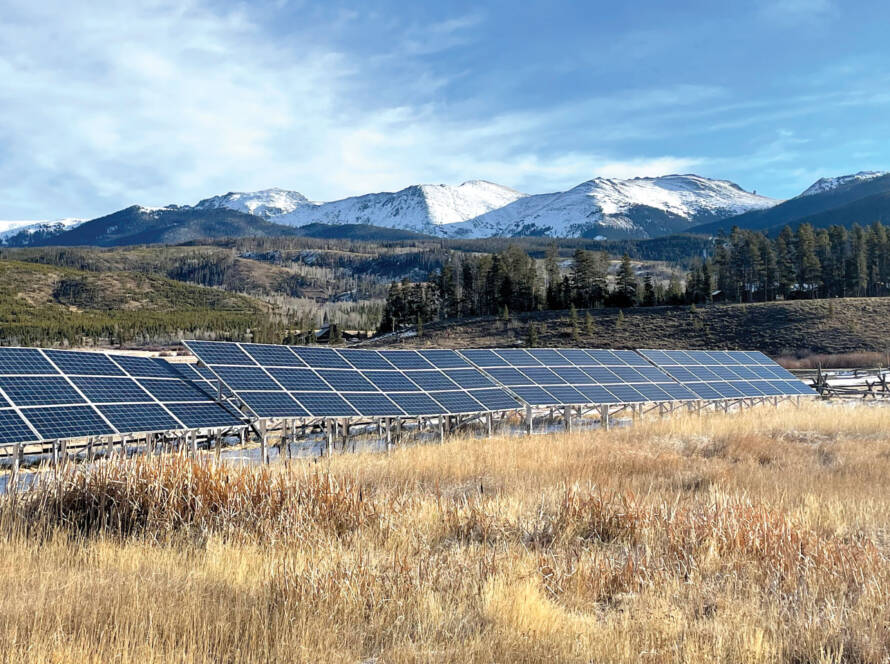In recent years, the winter sports industry has found itself at the forefront of climate change challenges. With rising temperatures, erratic weather patterns and changing snow conditions, ski resorts worldwide are grappling with the need to adapt and innovate. The National Ski Areas Association (NSAA) has been a trailblazer in addressing these concerns, and their annual Climate Challenge report serves as a vital compass for navigating the complex terrain of sustainability in the snow sports industry.
Beyond advocating for the interests of ski areas, the NSAA recognizes the urgent need to address climate change and its impact on winter sports. The Climate Challenge initiative is in its 12th year and aims to unite ski resorts in a collective effort to reduce their environmental footprint and promote sustainable practices.
Participants demonstrate their commitment by conducting an inventory and reporting on their greenhouse gas (GHG) footprint. They set targets for reducing GHG emissions, actively undertake at least one on-site GHG emissions reduction project annually and participate in climate change advocacy initiatives. Every year, participants submit a report that outlines their inventory of direct emissions from purchasing energy, waste disposal and business travel, their goal for reducing emissions, the steps resorts take to reduce their GHG emissions and their advocacy actions. Those who fulfill all Climate Challenge requirements are awarded both Climate Action and Climate Advocacy badges for the NSAA Sustainable Slopes Program.
The Climate Challenge annual report provides in-depth analysis of the industry’s progress in addressing climate change, reducing carbon emissions and implementing sustainable initiatives. The 2023 report, in particular, sheds light on the industry’s response to the ongoing climate crisis and highlights the innovative strategies employed by ski resorts to mitigate their environmental impact.
Pleasant Mountain in Maine and Crystal Mountain in Washington joined in the 2023 Climate Challenge. Smugglers’ Notch in Vermont and Bogus Basin in Idaho will join the Climate Challenge for the 2023-24 season.
Impact of climate change on ski resorts
The report opens with a stark assessment of the current state of climate change and its direct consequences on ski resorts. Warming temperatures, shortened winter seasons and unpredictable weather patterns are significant challenges.
Most resorts focus on implementing programs that have a positive impact on climate change. For example, Palisades Tahoe Ski Resort offers free parking to guests who carpool with four or more people in the vehicle, invested in renewable diesel to power their on-road diesel fleet and new snowmaking guns, have collected almost 60,000 pounds of compost, saved more than 100,000 bottles through the Drink Mountain Tap program and offers a free shuttle to the surrounding areas.
Renewable energy adoption
A noteworthy trend in the 2023 report is the increased adoption of renewable energy solutions by ski resorts. From solar panels to wind turbines, resorts are investing in clean energy alternatives to power their operations.
While enhancing the efficiency of electricity consumption remains a crucial strategy for numerous ski areas aiming to diminish their GHG emissions, the adoption of Renewable Energy Credits (RECs) has become an increasingly favored approach to curbing Scope 2 emissions (GHG emissions associated with indirect energy consumption). RECs function as the established legal instruments substantiating claims related to renewable energy generation and use in the U.S. renewable electricity market.
Goals of the Climate Challenge
- Higher standard: The program will raise the standard for ski areas wishing to take their sustainability performance to the next level.
- Long-term: The program will be multi-year, seeking to compound the benefits of actions taken by participants over many years and to grow the number of participants from year to year.
- Cost-efficient: The program will leverage the investment of participants and sponsorships to deliver more value to participants than their individual investments.
- Credible: Quantification of greenhouse gas inventories, targets and reduction measures will be developed in alignment with a credible protocol, using boundaries consistent with industry approaches.
- Transparent: The approach taken by the program will be transparent to participating ski areas and the public.
- Fair: The program will be fair, facilitating participation for ski areas of all sizes, regions and focuses.
- Easy: The program will provide participating ski areas with guidance and tools to make participation as simple as possible.
When calculating net Scope 2 emissions, ski areas deduct the RECs from their total energy consumption before applying the relevant emissions factor. As per reports obtained in the Climate Challenge annual report for 2023, the incorporation of RECs leads to a noteworthy 33 percent reduction in Scope 2 emissions, resulting in net emissions totaling 70,340 metric tons of carbon dioxide equivalent.
Big Sky Resort in Montana formalized their commitment to 100 percent clean energy with the purchase of RECs in 2021.
Snowmaking efficiency and water conservation
Given the changing climate, resorts are placing a renewed focus on snowmaking technology to compensate for unreliable natural snowfall. The report examines the efficiency of snowmaking systems and emphasizes the importance of water conservation in the process. Automation in snowmaking improves energy efficiency by reducing setup and shutdown times. That’s why Loon Mountain Resort in New Hampshire installed four fully automated fan guns and 22 semi-automated hydrants.
Likewise, Massanutten Resort in Virginia reported they installed high-efficiency automated snowmaking equipment as part of their skiing expansion. These new snow machines increase water pumped per kilowatt of electricity consumed.
Waste reduction strategies
Waste management emerges as a critical aspect of the sustainability equation for ski resorts. The report delves into waste reduction strategies that ski areas have implemented, including recycling programs, composting initiatives and the elimination of single-use plastics.
Big Sky Resort has expanded its composting program to include all food and beverage outlets and team member housing. Another example is Mammoth and June Mountain in California, which purchased a BioCoTech Biospeed composting machine for their mid-station facility and is estimated to reduce organic waste by 70 to 90 percent.
Powderhorn Mountain Resort in Colorado reduced waste through a partnership with Thunder Mountain Organics Recycling by implementing collection of compostable material in specially designated green bins. The composted material is returned to the resort and other local businesses and individuals.
Community engagement and education
Recognizing the need for a collective effort, the report showcases how resorts have engaged with their local communities to promote environmental awareness. Education programs, workshops and community outreach initiatives are highlighted as effective tools for fostering a sense of environmental responsibility among staff and visitors.
The advocacy element of the Challenge amplifies the importance of efforts made by the ski industry to leaders and legislators on a national level, and supports state, regional or national legislation or regulation targeting climate issues.
For example, Steamboat Ski & Resort Corporation in Colorado held its second annual Earth Day in April 2023 and provided guests with the opportunity to take action on climate change. Sugar Bowl Resort in California maintains a sustainability web page to educate visitors on their environmental initiatives and reduction goals.
Resorts’ advocacy
The advocacy element of the Challenge amplifies the importance of efforts made by the ski industry to leaders and legislators on a national level, and supports state, regional or national legislation or regulation targeting climate issues.
In the 2022-23 season, participants were required to complete an advocacy action in at least four of the areas selected by NSAA: climate solutions campaign or letter, direct correspondence, government meeting, community advisory committee, customer engagement on climate change, utility engagement and other (alternative ways participants advocate for climate change solutions at the federal, state and local levels).
A common theme in the “other” category was internal employee engagement such as action teams and progress tracking. Additional examples in this category include local student engagement and other forms of community engagement that address a broader audience than just guests of the ski area.
Climate Challengers were also encouraged to support the climate provisions of the Bipartisan Infrastructure Investment and Jobs Act (IIJA), the Build Back Better bill and the Inflation Reduction Act (IRA). The IIJA and IRA were signed into law, and represent record and historic investments in climate change solutions.
In this reporting season, customer engagement proved most popular, with 26 examples cited. Ski areas most often engage customers via on-site signage and digital engagement such as social media posts and dedicated sustainability web pages.
The NSAA’s Climate Challenge Annual Report for 2023 serves as a vital roadmap for the winter operations industry in the face of climate change. By addressing the challenges head-on and celebrating the successes, the report inspires ski resorts to take bold steps toward a sustainable future. As the industry navigates the slopes of change, the insights shared in this report will undoubtedly guide ski resorts toward a more resilient, responsible and environmentally conscious future. The NSAA’s commitment to sustainability underscores the industry’s recognition that protecting the winter playground requires a collective and unwavering effort.




![[image placeholder]](https://www.snowopsmag.com/wp-content/uploads/2023/09/placeholder@2x-890x664.png)